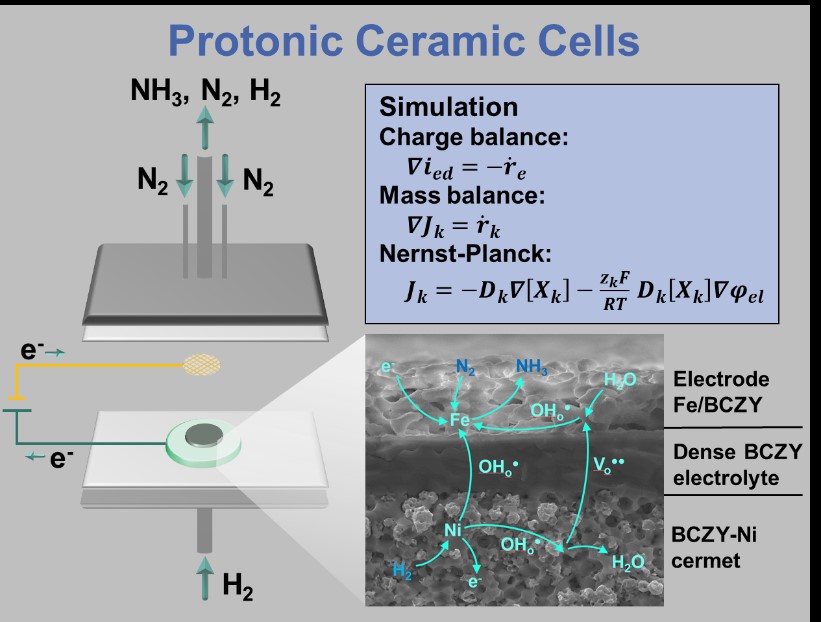Protonic ceramic cells
Background: Protonic ceramic cells (PCCs) represent an alternative to polymer electrolyte membrane fuel cells (PEMFCs) and solid oxide cells (SOCs). The operating temperatures of around 500°C for PCCs lie between those for PEMFCs and SOCs, thus combining advantages of both technologies. The main difference to SOCs is the defect chemistry and transport through the ceramic membrane-electrode assembly, which is governed by proton transport (H+) in PCCs.
Project: As an alternative to centralized Haber-Bosch, small-scale distributed ammonia synthesis has great value. Foregoing research was based on polarized PCCs, with either steam electrolysis or methane reforming on the anode, a proton-conducting ceramic membrane, and ammonia synthesis on the cathode. Protons likely play a significant role in catalysis. Because equilibrium ammonia synthesis rates decrease greatly as temperature increases, low-temperature (e.g., T< 450 °C) catalysis is needed. However, even with the best catalysts, synthesis is greatly reduced by kinetic limitations below about 500 °C. Practical PCCs usually operate between 500 and 700 °C. Electrochemical cells do produce ammonia, but at low rates. The proposed approach here is different – direct electrochemical activation of a novel catalyst support to increase synthesis rates greatly at low temperatures where the process is kinetically limited by N2 activation. The aim of the current project is the direct production of ammonia via electrolysis in an experimental setup using PCCs. The laboratory efforts are accompanied by the development of modeling tools which consider charged-defect transport through the electrolyte.
Contact: Philipp Blanck, Felix Ehrlich, Olaf Deutschmann
Funding: Deutsche Forschungsgemeinschaft (DFG)
Collaborations:
NSF-DFG Echem: Electrochemically Enhanced Low-Temperature Ammonia Synthesis
Partner Organisation: National Science Foundation (NSF)
- Dr. Julian Dailly (EIFER)
- Prof. Dr. Robert J. Kee, Prof. Dr. Huayang Zhu (Colorado School of Mines)
- Prof. Dr. Aayan Banerjee (University of Twente)
Related Publications:
V. Menon, A. Banerjee, J. Dailly, O. Deutschmann. Numerical analysis of mass and heat transport in proton-conducting SOFCs with direct internal reforming. Applied Energy 149 (2015) 161-175. DOI: 10.1016/j.apenergy.2015.03.037
H. Zhu and R.J. Kee. Modeling protonic-ceramic fuel cells with porous composite electrodes in a button-cell configuration. J. Electrochem. Soc. 164 (2017) F1400-F1411. DOI: 10.1149/2.0591713jes
J. Dailly, G. Taillades, M. Ancelin, P. Pers, M. Marrony. High performing BaCe0.8Zr0.1Y0.1O3-δ - Sm0.5 Sr0.5CoO3‑δ based protonic ceramic fuel cell. Journal of Power Sources 361 (2017) 221-226. DOI: 10.1016/j.jpowsour.2017.06.089

